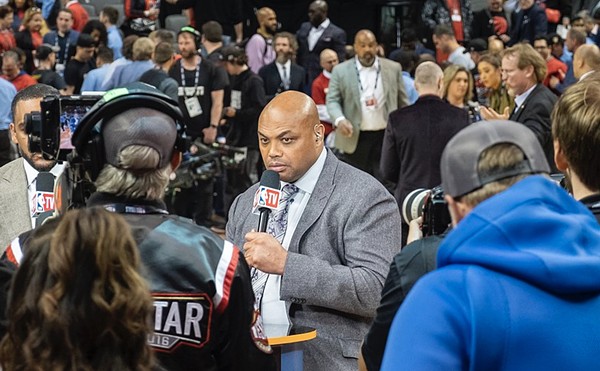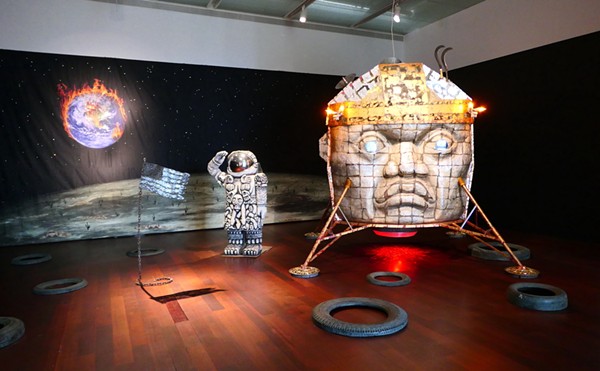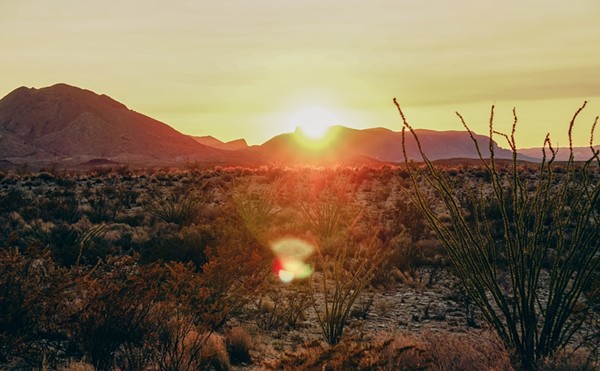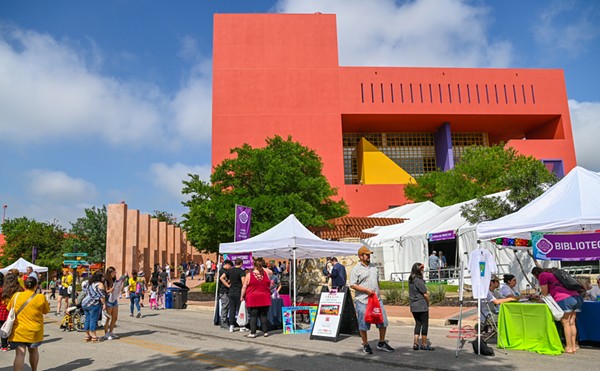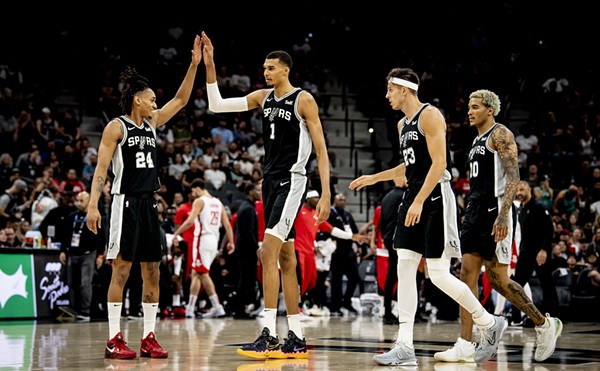When I first started writing about San Antonio’s art scene five years ago, there existed a narrow, but real, aspirational path of commercial galleries. A local artist’s ideal trajectory in, say, 2009, may have launched from University of Texas—San Antonio’s MFA program or the then-mighty Alamo Colleges art departments, aimed for a show at itty-bitty tastemaker Fl!ght Gallery, thence headed toward commercial grand dame Joan Grona and hopefully been picked up by tireless national market hustler David Shelton. Along the way, there would have been plenty of opportunity to build the all-important CV via artist-run spaces like Sala Diaz, Unit B or via the many important galleries in the Blue Star complex like Three Walls or Cactus Bra.
Fl!ght and Sala Diaz are still staging terrific shows, thankfully, but in 2012, with the Blue Star Complex re-development, Joan Grona retired her space there, ready to take a break after 20 continuous years. Last month, Unit B opted to "close its door indefinitely to ponder the future of the gallery and life in general," a hard-earned respite for artist/gallerist Kimberly Aubuchon.
See also: 22 Unforgettable Moments from Southtown Gallery Unit B
Cactus Bra, 19 years old, and Three Walls, 14, became casualties of the re-jiggering of Blue Star’s Building B in 2012. Also in 2012, David Shelton moved his brick-and-mortar gallery to Houston. As Shelton told the Current at the time of his relocation, “… being based in Houston will significantly increase exposure for the artists and their work among a diverse and highly sophisticated new audience, both within and beyond Texas.” True to his word, Shelton maintains several of San Antonio’s marquee names on his roster and prominently displays their works at high-profile venues like Texas Contemporary in Houston and Art Basel Miami. He is, in fact, raising San Antonio’s profile, which is all to the good.
But now, for emerging or mid-career local artists, the 2009 trajectory is dead. It seems the career ladder is flat on the ground rather than rising vertically, and after ascending one rung, the next local one is likely on the same plane and not necessarily above it. Even after going through all the rungs, without the inclusion in significant collections or recognition from regional and nation media that respected commercial galleries can bring, the artist may not be in any better position to grasp the brass rings of residencies, fellowships, faculty positions, grants and press needed to progress to the promised land of full-time professional artist.
Public art is one way up, though the competition is stiff and repeat commissions are generally awarded to artists with previous experience in that sector. There are some great profile-raising events in San Antonio, such as the Red Dot fundraiser at Blue Star, audience-driven Contemporary Art Month events and, arguably, Luminaria, which of late has seemed more like a committee-designed cattle call than an expertly curated arts celebration. Artpace’s Window Works installation series opens a “high art”-world resource to local mid-career artists, and pragmatically, it’s an impressive brand-name association for resume purposes.
So the current-landscape career catch-22 is this: Once a local artist’s career really picks up steam, there’s nowhere to go but lateral, maybe half-steps upward, or else leave town. There’s a void in the middle space, with hardly any jumping-off points between emerging-artist platforms and the kind of professional, mid-career institutions that lead to a bigger profile and, importantly, income. Our professional development and regional/national outreach blows.
I don’t want to bring you down—positive things are happening. On January 6, SAHearts and the City’s Department of Culture & Creative Development, headed by Felix Padron, made a presentation to the Cultural Arts Board, the PDF iteration of which, “Staff Proposed Arts Funding Guideline Revisions,” lays out a civic plan of engagement. The report draws from the SA2020 survey results, analyzes trends in San Antonio art culture (apparently they’ve noticed that “local artists are increasingly engaging in community development and recognized as key to the creative economy”) and proposes higher budget numbers for San Antonio-residing art makers, collaborations and nonprofit organizations participating in creating “a unique work or series specifically created by the artist(s) in order to engage community access and engagement with the arts.” The Department of Culture & Creative Development proposal encourages the use of non-traditional spaces, covers all genres of artistic output and, most hearteningly, proposes grant amounts up to $10,000.
But the public infrastructure, as crucial as it is, isn’t the same thing as a commercial art market and sales to collectors, universities or museums.
I feel semi-crappy even writing this is; after all, what are vulgar mercantilist concerns to a true artist? Isn’t the joy of expression enough? Don’t artists exist outside the realm of money-grubbing? Also, with commerce comes plenty of backbiting, the myriad collateral damages of competition, high stakes for little substance and even conceptual homogenization based on what sells. I went to an enormous art fair in Los Angeles last year that felt a little like Costco, and that was dispiriting. But while too much blatant collector-courting and careerism is a farce, too little is a catastrophe.
Rendered grouchy by these concerns, I scanned the horizon for new galleries, searching for emmerging trajectories. The good news is, they’re out there. I hope enough of them will stay solvent and mature into robust artist-run project spaces, generative collaborations, innovative experiments in moneymaking and even viable commercial galleries.
If you’re an artist, you should put these gallerists and their projects on your radar. If you’re interested in the art scene, check out the projects promoted by these peeps during CAM next month. And if you want to open a commercial gallery, a project space or join in a curatorial collective, pay special attention to the following lessons gleaned from your fellow hopefuls:
1. Evaluate the landscape, possible restrictions and zoning.
A hopping micro-scene is exciting but prepare for the concerns and potential static in your target neighborhood. One thing the Blue Stars and Southtowns have is the tacit approval of its commercial and residential neighbors. Without that, beware. An object lesson is the dilemma of French & Michigan, the highest-profile new indie space and San Antonio’s best hope for a commercially viable gallery that represents important local artists to a wider world, a la David Shelton.
The physical plant, at the corner of French and Michigan streets, is smack-dab in the middle of Beacon Hill, which seems in many ways to be supplanting Southtown as an arts scene. A terrific, welcoming two-story Spanish revival, the building also boasts an ideal position with a roomy corner structure that seems just right amid the artist studio spaces, houses and nascent community feel.
However logical the mixed-use site seems to enthusiastic urbanists, geographically, it may have garnered just enough public profile to get the arts community excited, while drawing the ire of those already concerned about area gentrification.
The building was originally zoned as commercial, but was re-zoned as residential. French & Michigan didn’t sort out the zoning limbo as part of their pre-planning. Busy devising a business plan, promoting, building an artist roster and opening for art and educational events, they applied to re-zone the building as commercial, whereupon they were met with hardcore pushback about the commercializing of the neighborhood by “outsiders,” which complicated their zoning appeal and has led to shuttering of the physical art space, at least for the time being.
I spoke to Billy Lambert, architect and one of three partners of the proposed gallery. Alongside fellow partner Celeste Wackenhut, formerly with the McNay Art Museum, the couple refers to themselves as the “mom and pop” of French & Michigan. Lambert’s also been a long-term resident of “The Compound” in Southtown, a cluster of casitas (including experimental gallery Sala Diaz) with a common outdoor space often used for art parties and fundraisers.
His role in establishing a physical venue, as well as his ideas about art dealing and curation, came “after living there, and talking to friends of mine about the gallery experiences they were having, versus what they wanted to happen.”
Lambert and co. expressed surprise at the Beacon Hill backlash (especially since the neighborhood association voted to support their zoning request) and frustration at the current impasse.
“The idea [of opening French & Michigan] was to bring art into the neighborhood, not to take anything away,” said Lambert, sitting under a lightweight, wavelike sculptural installation of interlocking plastic boxes, a site-specific design project by UTSA architecture students under Lambert’s mentorship.
About the gallery’s role as an educational resource he said, “ I wanted to work with students because I used to teach … I get a lot out of watching students work things out—or not have it work, exactly ... to struggle with executing [a project].” This process informs the French & Michigan mission, he says; a conglomeration of commercial space, experimental projects and educational outreach.
Wackenhut laid out the three dealer/curators’ ambitious plans to work with their already impressive roster of artists “to build their careers. My focus as curator isn’t [just] to organize theme shows or to put on a cocktail party with art in the background.” Wackenhut wants to cultivate a collectorship both in and outside of San Antonio, and to expand their artists’ and gallery’s scope, reaching out to collaborate and trade with curators and galleries elsewhere, showing their artists, in turn.
Meanwhile, French & Michigan was committed to making available smaller works by their artists, “to allow an entry point for young collectors to acquire contemporary fine art,” as Wackenhut said. This folks, is what big-city art dealers do, and we need this. I really hope the zoning eventually gets sorted.
Despite the location snafu, later this month we will see a French & Michigan group show opening in an as-yet unnamed pop-up location. Speaking of…
2. Embrace pop-ups and unconventional settings.
Jessica Garcia runs The Invisible Gallery, a brand-new physical entity in Beacon Hill Presbyterian Church’s “Michigan Building.” As a curator, Garcia’s best known for “Seven Minutes in Heaven,” a pop-up event heading into its third year. “Seven Minutes” takes over the seedy environs of the Fox Motel, transforming the rooms frequented by sex workers into art installations. The next one is on March 1, part of CAM festivities. By establishing her own voice and taking risks, Garcia’s earning an audience to follow her to her new digs, not the other way around. Fun fact: When asked if she was concerned about the Beacon Hill gentrification issue (the church is just three blocks away from the French & Michigan site), she answered, “Can I actually gentrify something, as a Mexican? I think if a Mexican does it, it doesn’t count.”
3. Have the courage of your convictions, and don’t apologize.
Unfortunately, many a well-meaning gallery falls by the wayside as a result of mission drift. A new gallery needs a strong curatorial voice and a pressing reason to exist. Don’t try to be all things to all people; focus is key. Sarah Castillo, the gallerist-curator of Lady Base at the venerable Gallista art space-cafe on South Flores, shows women only and focuses on the Mexican-American experience. She is also a full-time graduate student in UTSA’s Bicultural Studies program, and a member of the feminist Chicana art-making collective Más Rudas. “The art I create ties into my studies in graduate school, and [Lady Base] is the result of those two experiences. There’s cultural theory, art practice and activism all enacted in the space.” It’s broad enough to continually engage Castillo (another mission-killer can be simple boredom) yet focused enough to attract niche patrons. Smart.
4. Use the buddy system.
I talked to Lullwood Group members Connie Swann, Chris Castillo, Clay McClure, Julie Ledet and Joe Harjo. A curatorial powerhouse, their shows open at the 107 Gallery, formerly the LoneStar Studios, on Second Saturdays. One of the collective’s primary strengths is their complementary skill set. Between them, they’re able to execute witty, eye-catching social media promotion; handle the technical and logistical elements of transporting work; hang, light and stage an exhibition; write grant proposals; search out exciting regional artists; and solicit collaborators and exchanges with curators in major art centers. The result is truly greater than the sum of the their individual efforts, and leaves time for these artists to pursue their personal practices.
5. Make some damn money.
Louie Chavez and James “Supa” Medrano operate Plazmo Contemporary, taking cues from retail environments and translating them into sly, stylish installations at their artist-run space on the second floor of the same Beacon Hill church as Invisible Gallery. “I want the artists to go big … to use the space and be as experimental as they can be; I want to push their boundaries,” said Chavez. Meanwhile, he’s got to be realistic. “Obviously, a large-scale installation isn’t something a collector will usually buy … [so] we put out merch; stickers, prints, t-shirts, so that people can own a piece of it.
Everything you’re doing is branding. It’s not a dirty word.” According to Chavez, the commercial display has to have strong design and contribute to the work. Also, Plazmo’s relationship with exhibiting artists is baldly entrepreneurial: they take a 30 percent cut.
6. If you aren’t commercial, you still need to be organized.
The Lullwood Group is currently applying for 501(c)(3) non-profit status, which makes the entity exempt from payment of federal income tax. Once exempt, the nonprofit will usually be exempt from similar state and local taxes. This status also allows for public grants, tax-deductible charitable donations and limited liability under the law, meaning founders, directors, members and employees are not personally liable for the nonprofit’s debts. Very helpful if you get sued, apply for public funding or want to ensure the entity’s viability beyond founders’ participation.
7. Network hard but don’t be afraid to share the spotlight.
Alejandro Padilla, impresario of Studio Fantomas, is a canny assessor of social possibilities and isn’t afraid to negotiate. “I managed to get four artist studio spaces inside the Michigan Building,” he noted, securing studio space for artists Mari Hernandez, Audrya Flores and the aforementioned Louie Chavez and James Medrano, who “started right out of the gate as Plazmo Contemporary. Once they started having openings, I realized the opportunity to support them and show my work. At the same time, we have a large number of friends and patrons in common, so it seemed natural.”
In finding opportunities for other artists, he opens doors for himself. Also impressive to me: When I issued a call for gallery information on social media, Padilla responded immediately, identifying not only his own gallery, but providing links to nine others. In doing so, he got this writer’s attention, placed himself in a context of valid up-and-comers and raised awareness around a slew of spaces operating beyond his immediate circle. Aspiring gallerists, take note.




